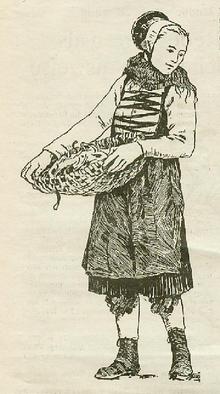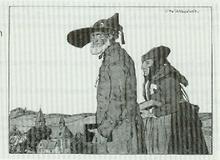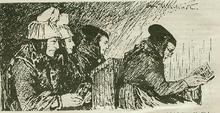Hinterland costumes


The Hinterland costume from the Hessian hinterland in the Central Hesse region is one of the oldest traditional costumes in Germany. Today it is exhibited in the Hinterland Museum in Schloss Biedenkopf . The Marburg orientalist and folklorist Ferdinand Justi (1837-1907) researched rural life in the Marburg area intensively in the last third of the 19th century and the traditional costume west of Marburg, especially the hinterland costume, with all its subtleties and colors in numerous watercolors ( far more than a hundred). The painter and fairy tale illustrator Otto Ubbelohde (1867–1922) also depicted the former costumes of the hinterland in many illustrations, including fairy tale pictures.
Emergence
Traditional costumes are the result of lengthy developments. In the past centuries, strict dress codes prevented the rural costume from developing itself. The rulers wanted to prevent the subjects from getting into debt through ostentation.
The imperial decree of 1530 determined
- "... that everyone, whatever their dignity or their origin, should be carried out according to their status, honor and ability, so that in each status there may be different understandings ...".
The peasants were allowed to wear a wide skirt, a smock with long trousers and an open hat. Gray was considered the predominant color of common man's everyday clothing, while blue dominated holiday clothing.
In 1772, a dress code was enacted in Hesse to prevent that
- "... large sums of money would be brought out of the country through the use of foreign goods, while the domestic factories and manufactories fell into ever greater decline."
In this order certain restrictions were imposed on the privileged classes, but the citizens, peasants and Jews were ordered to
- "... to wear no other witnesses, cloths, stockings, and hats than those made in this country, with the exception of cattunas and teats."
These regulations and the different fashion styles have left their mark on traditional costumes. Through the settlement of French religious refugees ( Huguenots ) in the Central Hessian area, who were endowed with special trade privileges, they also had an influence on the development of clothing, among other things. a. by using previously unknown ingredients such as braids, fabrics and other ingredients (small colored beads, thin metal wires, etc.)
According to a report by a government inspector from Kassel in 1800, there was a largely uniform black women's costume, which is said to have spread from Biedenkopf to Schwalm. In old pictures of country women from the area around Marburg you can see a costume that resembles the Hinterland official costume as it was worn around Biedenkopf, Dautphe, Holzhausen and in the Blankenstein office, but not with the Dellmutsche, but with the Schneppekapp (as in the lower court Office Blankenstein).
When the farmers became free after 1800 or were able to buy themselves free, the traditional costumes developed very quickly. The joy of color and the opulence in the design increased. Some women wore multiple skirts; also colorful, one on top of the other. Now the differences in the rulers, denominations, offices, courts and parishes developed. The young women competed with one another with variants, embroidery and ingredients that they then displayed on Sundays and at festivals. Traditional costumes, like today's clothing, were always subject to a certain fashion. This resulted in innovations and changes, mostly initiated from outside.
Formerly, different traditional costume landscapes lined up between Bad Hersfeld, Butzbach, Biedenkopf and Frankenberg. There were over 25 different forms of clothing here, a variety of traditional costumes that is unique in Germany. In their original form, the Hinterland costume and the Schwalm costume have been preserved the longest.
Women's costumes
There were five forms of the former women’s costume in the hinterland , although there were minor differences from village to village. Hans Friebertshäuser states in his book "The women's costume of the old office of Blankenstein":
- "For the structure of the hinterland traditional costume landscapes, the political and church internal boundaries were of particular importance: the official, court and parish boundaries."
The costume of the Battenberg office differed significantly from that worn in the Gansbach and upper Perftal (formerly Breidenbacher Grund Supreme Court), and this again in nuances from that of the Breidenbacher Grund (formerly Breidenbacher Grund lower court). The Official Biedenkopf (ex. Dautphe) formed remarkably, together with the upper Salzbödetal (ex. Supreme Court of the Office Blankenstein ), congruent with the former Parish Hartenrod and the present municipality Bad Endbach , a common uniform landscape. The "Dellmutsche" as headgear was the characteristic feature of this traditional costume variant. It differed from the costume of the former lower court of the Blankenstein office (today the city of Gladenbach ) almost only in the "Schneppekapp", the different kind of headgear.
The basic black color of the Hinterland costume was also called "schwoaze Klärer-Trocht" (black dress costume) in colloquial language. The costume was a Protestant costume; therefore the black dominated, while the catholic costume z. B. in Ebsdorfergrund and around Ämöneburg (southeast and east of Marburg) was much more colorful. The clothes were seldom made themselves, but mostly by special costume tailors ( called seamstresses ); with the exception of the embroidery, which was done by hand by the women.
There were also hat makers who prefabricated hats and then fitted them to the wearer on site. The black of the skirts and motzen (bodice) harmonized particularly well with the subtle but colorful embroidery on the sleeves of the Motzen, the upsets (decorative sleeves that were worn under the wide white shirt sleeves), the breastscarves and the garters.
Age and marital status as well as Sunday, church attendance, communion, festive and mourning clothes and work clothes could be recognized by the colors of the doublet / moth, apron, neckerchief and the embroidery on the breast cloth, compression, garter belt and shoe strap.
The following color rules applied to traditional costume accessories and embroidery: red was reserved for girls and unmarried women, green for young married women , blue and purple for older married women, at the latest after the last child had been confirmed. The strong bright colors of the accessories and the embroidery gave a good contrast to the black basic color. From a certain age, e.g. For example, if the first grandchild was born and as a widow there were no more colors or embroidery "befitting" (inappropriate), then one only wore black with subtle white .
The costume knew no coats. Instead, in winter and when it was cold, the women used a large, dense dark woolen cloth that reached from the head to the waist and was used as a cloak like a sleeveless poncho. This could cover the entire body, including the head if necessary. The front door was held together with one or two large clasps.
The heyday of the old Hinterland women's costume was around 1880/90, after which it was no longer developed. In addition, the new Protestant women's costume pushed into the hinterland from the east, from the Marburg area. It had a more modern cut and used lighter, industrially manufactured fabrics and more colorful colors. A complete Hinterland costume with its thick and heavy fleece and double-walled fabrics could weigh 5 to 7 kilograms. Therefore, from the end of the 19th / beginning of the 20th century, many families began to dress their daughters in traditional Marburg costume instead of the Hinterland costume, as many family pictures from this period show.
- Hinterländer traditional costumes by Ferdinand Justi
Wommelshausen , grandmaid in summery Sunday attire (with Dellmutsche), Blankenstein Supreme Court
Bottenhorn , Sunday costume , Blankenstein Supreme Court
Steinperf , festival costume (with Mutsche), Breidenbach High Court
Breidenstein , "Zwei Rotkäppchen" (red Kiwelcher), Lower Court Breidenbach
Dautphe , Sunday costume in two versions, Amt Biedenkopf
Holzhausen am Hünstein , Biedenkopf office
City of Biedenkopf , Sunday costume
Office Battenberg (Eder)
Men's costumes
There were only a few forms of men's costume, namely: blue smock, white smock, as well as white shirt with black bow, colorful waistcoat, dark blue kerchief skirt and wide-brimmed hat.

With the blue coats, a distinction was made between the longer Sunday coats with embroidery on the cuffs and sleeves and the shorter, unadorned everyday coats. The men's costume differed only in details (e.g. the embroidery on the smock) from that in the neighboring Marburg area. The black Sunday smock made of shiny fabric no longer existed here in the late 19th century.
Originally - until around the middle of the 19th century - the men's costume consisted of a knee-length white linen smock, trousers, woolen stockings, buckled shoes, a wide-brimmed hat (also known as a slouch hat) or a round fur hat.
The blue or white smock is not a typical Hinterländer or even Hessian costume item. It is an old widespread piece of clothing e.g. B. as a driver's smock. He was formerly u. a. worn in Baden, Württemberg, Switzerland and Burgundy. Even as blue or blue-and-white striped workwear, it remained in use for a long time in a short, hip-length version as a shepherd's, fisherman's (Frisian), carpenter's, vintner's, cooper, butcher's and locksmith's smock for a long time.
The blue and white pointed cap was generally worn as everyday headgear, and a round otter skin cap was also worn with the Sunday costume (as in the Schwalm); A round, colorful cloth cap (so-called Meesche ) was also known. Later, a round hat with a narrow brim became popular.
A white shirt with a black bow or scarf, a vest or jacket (light blue, gray, green or red), a dark blue, narrowly cut knee-length cloth coat with long rows of buttons and light lining, and long, narrow black trousers belonged to the proud costume (festival and church attire ) or knee breeches made of white linen or yellow leather, white stockings and black short boots or buckled shoes and always a wide-brimmed hat, e.g. B. slouch hat or three-master .
- Hinterland male costumes, pictures by Ferdinand Justi
Wommelshausen, cowherd in everyday costume with ringlets and Simmental Fleckvieh cow
literature
- Ferdinand Justi: Hessisches Trachtenbuch , ed. Günther Hampel, Dr. Wolfram Hitzeroth Verlag, Marburg 1989 (reprinted by Elwert Verlag, Marburg 1899–1905)
- Hans Immel: The women's costume in Wommelshausen , semester thesis autumn 1937, Pädagogisches Institut Weilburg, 49 pages (typewritten) with numerous photos, patterns and cards
- Hans Friebertshäuser: The women's costume of the old office Blankenstein , NG Elwert Verlag, Marburg 1966
- Wolf Lücking: Traditional costume life in Germany. Volume III: Hesse. Introduction by Mathilde Hain. Akademie-Verlag, Berlin 1969
- Brunhilde Miehe: Staying true to the costume, studies on regional clothing behavior in Hesse , 2nd edition 1995, Brunhilde Miehe Haunetal / Wehrda publishing house, ISBN 3-9801197-7-7
- Ursula Ewig, Annelies Born: The women's costume in Breidenbacher Grund , Marburg 1964
- Dorothee Henssen: The women's costume of the old Biedenkopf office , Marburg 1963
- Sigrid Ebert: The Marburg women's costume , 2nd edition, Marburg 1987
- Günter Bäumner : The hinterland - once a colorful landscape of traditional costumes , in: Active Age, 1979, No. 10
- Margarethe Dieffenbach: Hessischer Trachtenalltag , Frankfurt 1983
- Christoph Kaiser: The costume as changeable clothing , Munich / Ravensburg, 2nd edition 2009, ISBN 978-3-640-18857-4 (book), ISBN 978-3-640-18704-1 (e-book)
Web links
swell
- ↑ Roman Imperial Majesty Order and Reformation of Good Policies, in the Holy Roman Empire, at Augburg Anno 1530 Auffgericht , at www.uni-muenster.de , accessed on September 18, 2017.
- ↑ Hans Friebertshäuser: Dialect and folk life in the old district of Biedenkopf. Volksbank and Raiffeisenbank Biedenkopf-Gladenbach, Biedenkopf 1998, pages: 98 to 102
- ↑ Hans Friebertshäuser: The women's costume of the old office Blankenstein , NG Elwert Verlag, Marburg 1966
- ↑ Horst W. Müller, Wommelshausen - a village book , 2nd edition, Marburg 1995, pp. 176–185, Die Frauentracht im Obergericht
- ↑ Hans Immel: Die Frauentracht in Wommelshausen , semester thesis autumn 1937 at PI Weilburg, 49 pages (typewritten) with numerous photos, patterns and cards (unpublished)
- ↑ Siegfried Becker, Clemens Brentanos "Cirkassierinnen aus Oberhessen", On the dating and aftermath of watercolor pictures with Blankensteiner costume , in "Amt Blankenstein", magazine of the Heimat- und Museumsverein eV Gladenbach, issue 19, April 2009


















